Surgical scissors are an essential tool in every operating room, allowing surgeons to make precise and controlled incisions. These specialized scissors are designed to cut through different types of tissues, including delicate ones, with accuracy and minimal trauma.
In this article, we will explore the eight different types of surgical scissors that are commonly used in medical procedures with examples, their unique features, and how to choose the right one for specific surgical tasks. So, here we go—time to get things underway!
8 Most Popular Surgical Scissors
Here’s an explanation of each type of the most popular surgical scissors:
#1. Operating/Surgical Scissors
The workhorse of the operating room, operating scissors—also known as surgical scissors—emerged as the most popular cutting instruments. They exhibit versatility, catering to a wide array of surgical tasks, such as cutting sutures, dressings, and tissues. Sporting robust, straight blades with blunt tips, these scissors facilitate both delicate and heavy-duty cutting. They come in various lengths and find common use across all surgical specialties.

Examples:
#2. Metzenbaum Scissors
Surgeons widely consider the Metzenbaum scissors as the go-to tool for delicately dissecting and cutting soft tissues. Their long, slender blades and fine tips offer excellent visibility and control during surgical procedures. Plastic surgery, neurosurgery, cardiovascular surgery, and general surgery commonly employ these scissors. Additionally, Metzenbaum scissors come in various lengths to accommodate different surgical needs.
Examples:
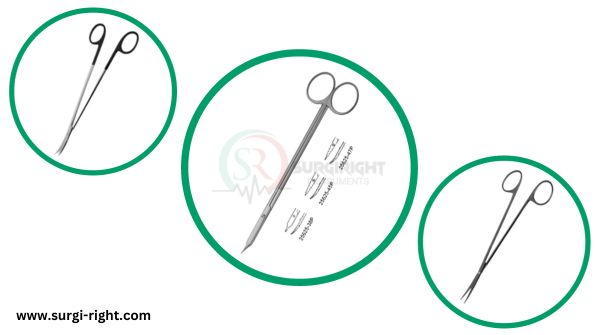
#3. Iris Surgical Scissors
Surgeons originally named iris scissors due to their use in eye surgery, specifically for delicately cutting eye tissues during cataract procedures. However, their versatility has made them popular in other surgical specialties as well. These scissors have small, sharp blades with fine tips that allow for precise and intricate cutting in tight spaces. Moreover, they are commonly used in ophthalmology, dermatology, and plastic surgery.
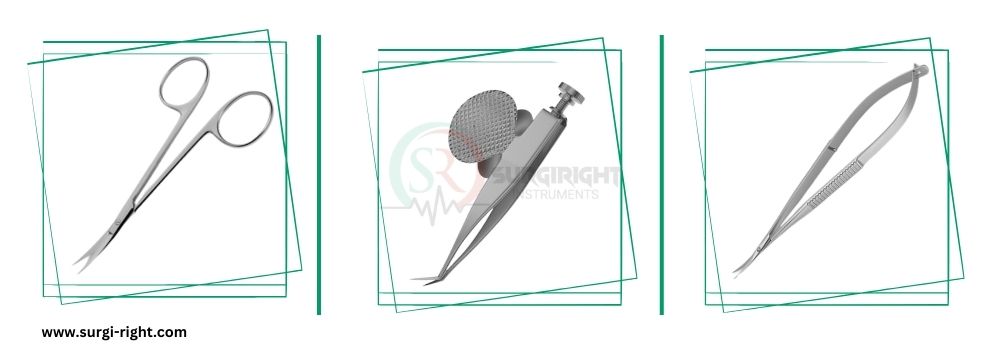
Examples:

#4. Mayo/Dissecting Scissors
Mayo scissors, also known as dissecting scissors, are a staple in the operating room. They are designed for cutting heavy or tough tissues near the wounds, such as muscles, fascia, and sutures. The blades of Mayo scissors are thick and curved, allowing for increased cutting power. These surgical scissors are commonly used in general surgery, orthopedics, and gynecology. After all, they are available in various lengths to suit different surgical needs.
Examples:
#5. Bandage/Utility Scissors
Bandage scissors, also known as utility scissors, are specifically designed for cutting bandages, dressings, and other medical materials. They have a unique blunt lower blade that helps prevent injuries to the patient’s skin while cutting. Bandage scissors often feature a hooked or contoured upper blade, allowing for easy removal of bandages without harming the underlying tissue. However, these scissors are commonly used in emergency departments, clinics, and home healthcare settings.
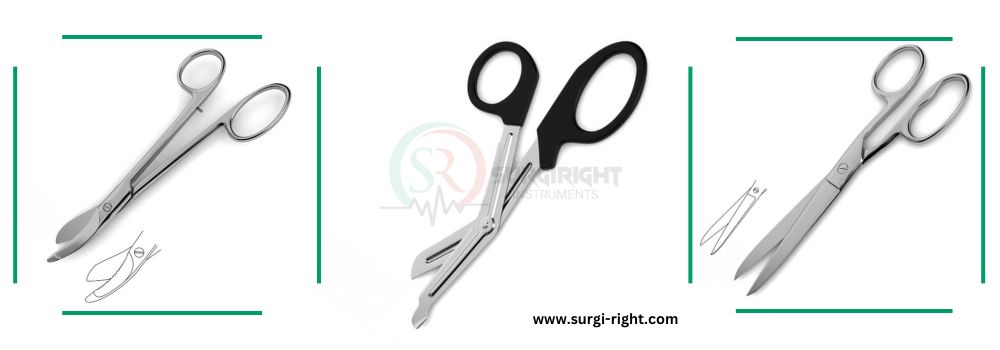
Examples:
#6. Dermal Scissors
Dermal scissors are specialized scissors used for cutting and removing skin tissues during dermatological procedures. They have thin, sharp blades with fine tips that allow for precise and controlled cutting of the skin. In addition, dermal scissors are commonly used in dermatology, plastic surgery, and cosmetic procedures. Hence, they are available in various sizes and designs to accommodate different surgical needs.
Examples:
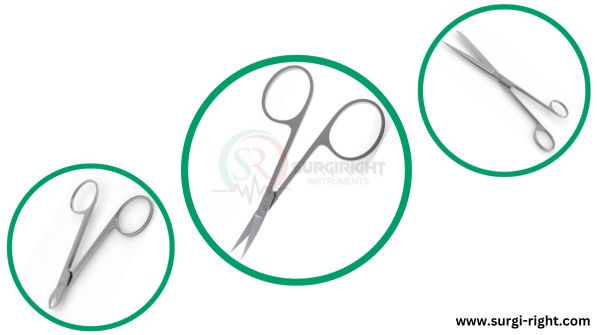
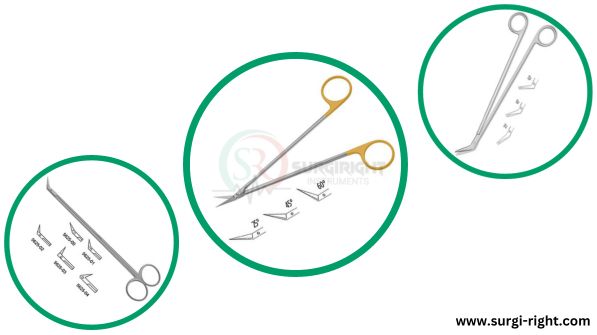
#7. Potts Surgical Scissors
Potts scissors are long, slender scissors with a curved blade that tapers to a sharp point. They are primarily used in neurosurgery for delicate dissection and cutting of neural tissues. The unique design of Potts scissors allows for precise control during intricate procedures. These scissors are commonly used in neurosurgery and other specialties that require delicate tissue handling like orthopedic surgeries.
Examples:
#8. Stitch/Suture Scissors
Stitch scissors, also known as suture scissors, are specifically designed for cutting sutures during wound closure. They have small, sharp blades with pointed tips that easily slip under sutures for quick and efficient removal. Stitch scissors are commonly used in all surgical specialties and are an essential tool for wound care.
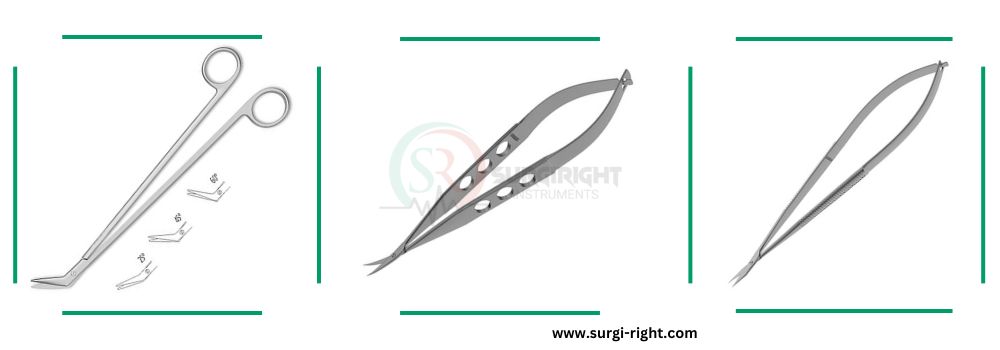
Examples:
Factors to Consider When Choosing Surgical Scissors
To ensure optimal performance and safety, consider these factors when selecting surgical scissors:
- Blade Material – Surgical scissors manufacturers typically use stainless steel or high-quality carbon steel for the blades. Stainless steel scissors resist corrosion and are easy to clean, whereas carbon steel scissors provide exceptional sharpness and durability.
- Blade Design – Different blade designs serve specific surgical tasks: Straight blades offer versatility for general cutting, while curved blades enhance access to specific anatomical structures.
- Blade Length – Scissors also come in various lengths, ranging from small, delicate scissors for fine dissection to longer scissors for deeper tissues. However, choosing the appropriate length depends on the surgical procedure and personal preference.
- Handle Design – Additionally, the handle design should provide a comfortable grip and allow for precise control. Ergonomic handles with finger loops and a textured surface can enhance maneuverability and reduce hand fatigue during long procedures.
- Sterilizable – Moreover, surgical scissors should be easy to clean and sterilize to maintain a clean surgical environment. Look for scissors that can withstand various sterilization methods such as autoclaving or chemical sterilization.
Conclusion
Surgical scissors play a crucial role in achieving precise and controlled incisions during surgical procedures. From the delicate dissection of soft tissues to the cutting of heavy-duty sutures, there is a wide range of scissors available to meet the specific needs of each surgical specialty. However, when choosing scissors for surgeries, it is essential to consider factors such as blade material, design, length, handle design, and sterilizability. By selecting the appropriate scissors for each task, surgeons can ensure optimal outcomes and patient safety in the operating room.
Remember, the most popular and right surgical scissors are an essential investment for any surgeon or medical professional. So, choose wisely with Surgi Right, and snip each tissue with precision.

